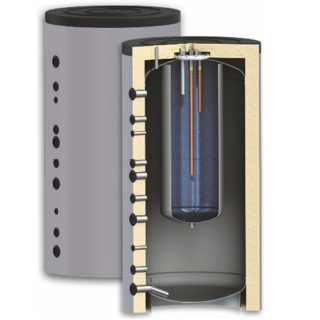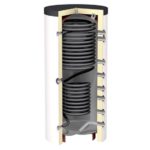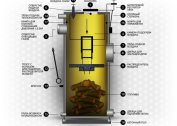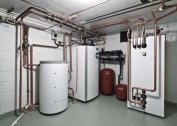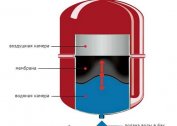In homes where there is no gas or central heating, individual heating systems are used, including solid fuel and electric boilers or solar systems that run on solar energy. These systems have an important drawback - uneven heating medium due to the fundamental features of the functioning or influence of external factors. They can be optimized using a heat accumulator for heating, which will play the role of a buffer between the heat source and consumers.
The purpose of the heat accumulator
The heat accumulator for various types of heating boilers is an impressive tank filled with water, which allows you to solve problems that arise during the operation of the heating boiler:
- energy overrun;
- excess heating power;
- overheating of water in the boiler;
- periodic fluctuations in the heating temperature due to the unevenness of the combustion process itself and the untimely laying of firewood, coal;
- mismatch of peaks in the production and consumption of thermal energy.
Some of the problems can be solved by installing a pyrolysis boiler for long burning, but in the latter case it will not help. The peculiarity of the operation of the boiler is that after the laying of fuel, the heat transfer power gradually increases, reaching peak values, and then also gradually decreases. If fuel is not added to the boiler in time, it stops, the coolant starts to cool, and with it the temperature in the house drops. During peak heat production, the system is not able to efficiently distribute all the energy, since it is equipped with temperature controllers, so part of the heat is wasted. If the boiler is electric, it is much more profitable to accumulate heat at night, when electricity is calculated at a reduced night rate, so as to consume as little electricity as possible during the day.
The heat storage tank for the heating system is made of stainless or ordinary steel, and can be coated with a protective varnish from the inside. The walls on top are painted with heat-resistant paint, then they are closed with heat-insulating material and leatherette. In fact, when the heat accumulator is connected, the volume of the coolant in the heating system increases, which allows you to compensate for the peak power of the boiler and at the same time accumulate heat to transfer it to the coolant when the power of heat generation by the boiler drops. Thanks to high-quality insulation, the water in the heat accumulator cools for a long time. It is stored in a heated state for several hours and even days and is fed into the system through a pump. The principle of operation of the heat accumulator is based on different heat capacity of various environments, in particular water and air. A decrease in the temperature of 1 liter of water by one degree leads to an increase in air temperature of 1 m3 by 4 degrees.
If using solid fuel and electric boilers, installing a heat accumulator is desirable but not necessary, then the presence of a heat accumulator in the solar system is a necessary condition for functioning, since it is impossible to obtain solar energy in the evening and night, and in the autumn and winter on cloudy days the use of the system is very limited.
Advantages and disadvantages
Pros of using a heat accumulator:
- Keeps thermal energy for several hours and days.
- Boiler overheating is excluded.
- Thermal energy is not wasted, but accumulated to be used in the future, due to this the efficiency of the boiler and the heating system as a whole increases.
- Allows you to save financial resources.
- The air temperature in the rooms is easily maintained at the optimum level, sharp jumps in temperature are excluded.
- No need for frequent fuel downloads.
- In addition to a solid fuel boiler, you can install a solar system, which is a free source of thermal energy.
- Some models of thermal accumulators for heating can combine the functions of a boiler.
The disadvantages of the system:
- Long heating - optimal installation in homes intended for permanent residence. In summer cottages, which are visited in the winter on weekends, such a device will not bring benefit.
- High cost - they cost about the same as a boiler, and sometimes more expensive.
- Significant dimensions and weight - because of this, certain difficulties arise during transportation and installation. In addition, a heat accumulator intended for heating is installed in the immediate vicinity of the boiler, additional equipment must be located there, so it is often necessary to allocate a special room for the installation of devices and prepare it in a special way: equip a supporting platform that can support the weight of the accumulator. When filled, the tank can weigh 3-4.
- A high-power boiler is required - buying a drive is justified if the boiler’s power is not fully utilized, there is at least double power reserve, otherwise the device will be inactive.
In the manufacture of a heat accumulator with your own hands, you can save a significant amount. The simplest design is made of stainless steel barrel or even stainless steel sheet with a thickness of at least 3 mm. A copper tube with a diameter of 3 cm and a length of 14 m will also be required. It is bent in a spiral and placed inside the tank. From below, make cold water supply, from above a tap for hot, install stopcocks on the taps. It is absolutely necessary to insulate a heat accumulator made by yourself for a solid fuel boiler, otherwise it will be ineffective. It is also necessary to install pressure and temperature sensors.
If it is not possible to weld a cylindrical container, you can make a heat accumulator for heating in the form of a parallelepiped - it is easier to make a tank of this shape with your own hands. The corners additionally reinforce, on the outside they complement the design with stiffeners - they are welded at a distance of 30-35 cm from each other. The ratio of the diameter and height of the device is 1: 3 (4).
Selection Criteria

It is necessary to select a heat accumulator in accordance with accurate calculations that take into account the parameters of a home heating system. However, in addition to the calculated values, the general characteristics of thermal storage devices are taken into account.
- Pressure in the heating system. According to this parameter, the heat accumulator must correspond to the heating system. In any case, the value may be higher, but not lower. What pressure the drive can withstand depends on the wall thickness, the shape of the tank, and the material of manufacture. The heat accumulators for boilers withstanding more than 4 bar have convex lower and upper covers.
- The volume of the buffer tank. This parameter is considered the most important and they try to choose a capacity of such a volume that the drive can accumulate all the excess heat. But at the same time, an overly voluminous device is not needed.
- Outside dimensions and weight. The transportation and placement of equipment will have to be addressed, therefore, everything must be carefully calculated: will the tank pass in the doorway, will the floors withstand the tank when it is completely filled with water.
- Equipping with additional heat exchangers.They allow you to further optimize the functioning of the system. Models are selected in accordance with the complexity of the entire system.
- Ability to install additional devices. Together with the battery clipboard, additional heating elements, sensors and temperature controllers are installed. If all the elements of the system are selected correctly, you can reduce fuel consumption by half.
Tanks are made of carbon steel or stainless steel. The latter are more expensive and last longer, and the former necessarily have anti-corrosion coating. You must make sure of its quality.
Calculation of the volume of the buffer capacity of the boiler

According to the calculations, the heat accumulator must take all the energy from one tab of fuel into the boiler
The volume of the buffer tank is usually calculated so that during the burning of one bookmark of fuel, the heat accumulator retains all the heat generated by the boiler. Only approximate calculations can be made on their own, not taking into account heat loss from heating radiators and the influence of room temperature. The basic formula for calculating the volume of the heat accumulator:
W = k × m × s × Δtwhere
- W - excess heat;
- m - mass of liquid;
- with - heat capacity of the coolant;
- Δt - the number of degrees by which to heat the coolant;
- k - boiler efficiency.
From here you need to calculate the mass of the coolant:m = W / (k × s × Δt).
As W is defined as the difference in the values of energy generated by the boiler and spent on heating the house, it is also necessary to clarify them and the burn-in time of the fuel bookmark. If the boiler power is given in the device certificate, the heat energy consumption for heating must be calculated. The fuel burn-up time is determined empirically. Let's say it's 3 hours, and it takes 10 kW / h to heat a house. So, in 3 hours it will be spent:10 × 3 = 30 kW.
Heat generation by a boiler with a capacity of 22 kW / h is:22 × 3 = 66 kW.
According to the calculation results, excess heat will be:W = 66 - 30 = 36 kW. We translate in watts, we get 36000 watts.
Using the formula m = W / (k × s × Δt), determine the desired value of the mass of water. Efficiency is indicated in the passport as a percentage. This value must be converted to decimal, divided by 100. For example, 80/100 = 0,8. The heat capacity of water is 4.19 kJ / kg × ° C or 1.164 W × h / kg × ° C or 1.16 kW / m³ × ° C.
Δt determined by measuring the temperature of the supply and return pipes, subtracting the smaller from the larger value. For instance:Δt = 88 - 58 = 30 ° C.In this way,m = 36000 / (0.8 × 1.164 × 30) = 1,288.7 kg.
To preserve all excess energy generated by the boiler, a capacity of at least 1,288.7 m3 is required. The Jaspi GTV Teknik 1,500 liter heat accumulator is suitable. With more modest calculation values, you can limit yourself to a tank, for example, to 750 liters.
DIY methods and schemes
The complexity and features of the connection depend on the type of heat storage. Therefore, you should understand what they are.
- The simplest design is an empty tank inside. The boiler and consumers are connected directly. Use is optimal if the same coolant is used in all circuits, the pressure in the system does not exceed the permissible values of the accumulator and the temperature of the coolant supplied from the boiler does not exceed the allowable values for the heating circuit. If the first two requirements are not met, when connecting to the system, you must use additional external heat exchangers. In the latter case, mixing units with three-way valves should be installed.
- Buffer tank with an internal heat exchanger - one or more. The heat exchanger is a spiral pipe made of copper or stainless steel. In such a storage medium, the coolant is mixed. The coil located in the lower part heats the coolant, hot water rushes upward as less dense.At the top is another coil that takes energy and brings it to the heating circuits. A device of this type is optimal when using different types of coolants, at high pressure and coolant temperature, and connecting several heat generators.
- The tank with a flowing circuit of hot water supply. The heat exchanger is mostly located at the top of the tank. It should be made of metal that meets the standards of food water consumption. Circuits are connected directly. Such a system is preferable with an even flow of hot water.
- Heat accumulator with an internal boiler. Heated water for domestic consumption is stored in the storage tank. This type of heat accumulating battery can be easily integrated into open and closed heating systems equipped with solid fuel, electric boilers and solar collectors. Buffer tanks of this type are especially relevant when using electric boilers, when the heat carrier is heated at night, and water is consumed during the day. A 150 liter boiler is enough for an average daily consumption of water by an average family.
- Instantaneous heat accumulator
- With a boiler
- With heat exchanger
There are several outlet pipes for the heat accumulator intended for the heating system, and they are located along the tank vertically, since there is a temperature gradient along the height. This is done so that it is possible to connect circuits with different requirements for the temperature of the coolant, to reduce the load on the temperature controllers. As a result, thermal energy is used as efficiently as possible.
Other types of systems:
- A simple strapping scheme that limits the ability to adjust. Hot water rises and is taken from the upper point, after cooling down, it drops and enters the boiler again. It is used if the pressure and temperature in the heat generator and heating circuits are the same. The temperature is regulated only by increasing / decreasing the flow of coolant.
- In the system there are mixing units, bypasss, therefore more precise adjustment of the temperature of the coolant is possible. Equipment efficiency is achieved through the installation of, for example, three-way valves.
- An additional tank is included in the system, due to which a small volume of hot water is available immediately after the boiler starts. The consumer does not have to wait until the system is fully heated, but the water supply is not large, and the system heats up more slowly than the classical one.
- There is one coil inside the buffer tank, thermal energy from the source passes through it, and the coolant in the heat storage tank is already heated from the coil. In a system of this type, different coolants are used. You can choose those that can not be mixed due to incompatibility of chemical characteristics. Through the coil, heating or hot water can be supplied, or the coolant from the source will circulate in this circle.
- An additional external heat exchanger is installed in the system. It allows you to maintain the desired temperature in the battery.
- System with a flowing circuit of hot water supply. It is optimal if hot water is used evenly. Otherwise, it is recommended to purchase an energy accumulator with a built-in boiler.
- System with one coil and connection to an alternative energy source, for example, a solar collector. It is called bivalent. The connection is carried out in such a way that the collector plays a leading role in the heating of the system, and the boiler is connected when there is not enough thermal energy.
- A multivalent system where the main heating is carried out by low-temperature sources, for example, a solar collector and a geothermal heat pump.They are connected at the bottom of the heat accumulator. A high temperature boiler is used as an auxiliary source of thermal energy.
In the presence of various heating circuits and sources of thermal energy, a complex branched system is formed with many additional adjusting equipment, sensors, and security groups. It is recommended to entrust its design to professionals, as high-precision calculations will be required.
Battery harness for heat
The container must be well insulated. If this is a purchased heat accumulator, you need to evaluate the thickness and quality of the external insulation. The better and thicker the heat insulator, the longer the heat will remain. Thanks to the special structure of the heat insulator, the heat accumulator works like a thermos. The thickness of thermal insulation in high-quality models is about 10 cm. It covers the body painted with heat-resistant paint. On top of the insulation is a layer of leatherette. Self-insulation is carried out according to the same scheme. First, the tank is painted with a paint that is resistant to high temperature, then it is insulated with basalt cotton wool with a thickness of at least 150 mm, and the top is covered with foil.

